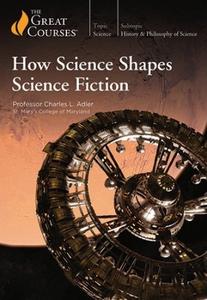TTC Video - How Science Shapes Science Fiction
"softddl.org"
29-09-2020, 19:27
-
Share on social networks:
-
Download for free: TTC Video -
-

TTC Video - How Science Shapes Science Fiction
Course No. 2358 | .MP4, AVC, 1900 kbps, 1280x720 | English, AAC, 96 kbps, 2 Ch | 11h 47m | 10 GB
Lecturer: Charles L. Adler, PhD
 TTC Video - How Science Shapes Science Fiction Course No. 2358 | .MP4, AVC, 1900 kbps, 1280x720 | English, AAC, 96 kbps, 2 Ch | 11h 47m | 10 GB Lecturer: Charles L. Adler, PhD Science fiction has been called "the literature of the future," but how often do writers get the science right? Most of us are familiar with the common features of the genre: interstellar travel, laser weapons, alien technology, teleportation, artificial intelligence, time travel, and more. But how much do we know about the science behind the stories and their imaginative worlds? It's true that these are, indeed, science fiction, but you may be surprised by how much scientific reality lies at the heart of well-known science fiction tropes. Whether science fiction is exploring current realities, extrapolating from the present to create imaginary futures, or just creating interesting settings for character-driven stories, it often relies on real science to both entertain and build stories that can transport us into astonishing new worlds. In the 24 lectures of How Science Shapes Science Fiction, Professor Charles L. Adler of St. Mary's College of Maryland looks at dozens of books, movies, and television shows to unearth the science behind the fiction. From the physics of space flight and the ecology of exoplanets to the creation of alien languages and the paradoxes of time travel, you will uncover the ways real-world science is applied by writers and filmmakers-and consider what they might alter or leave out for the sake of a good Description. Over the course of these 24 lectures, you will engage with work from dozens of great names in science fiction, including: Jules Verne; Isaac Asimov; Arthur C. Clarke; Stanley Kubrick; Frank Herbert; Ursula K. Le Guin; Becky Chambers; and Robert Heinlein. And you will have the perfect guide as you immerse yourself in the work by these and many other sci-fi storytellers. With over 30 years of experience in the field of physics, Professor Adler presents the many scientific facts and theories throughout this course with clarity and good humor, using science fiction as a lens through which we can better understand our own world and expand our understanding of vital scientific principles. While it isn't necessary to read or watch the many stories explored in these lectures to understand the science, your experience will be greatly enhanced if you have encountered these tales before. Reading Fiction Scientifically If science fiction is about entertainment, why dig into the accuracy of the science? As Professor Adler demonstrates, fiction can be a wonderful gateway to education as well as entertainment. Through the dozens of novels, films, and television shows he discusses in this course, you will see how fiction can both directly and indirectly reflect the real-world concerns of scientists and everyday people alike. And, rather than taking stories to task for failures of accuracy, or only praising those with the most "truth," Professor Adler enriches your experience of these stories. He provides an in-depth analysis of dimensions many could miss out on in a solitary experience with these narratives and helps you engage with science in a highly accessible way. As you dive into stories by great writers and filmmakers that span the history of science fiction, you will examine: How science is applied in a variety of stories and storytelling mediums; The ways writers can "cheat" science to bend it to the needs of their stories, rather than forcing fiction to fit reality; The predictive powers of fiction rooted in real science; The many scientific fields that sci-fi writers can use to build their story worlds; When accuracy helps a story and when it bogs it down in excessive scientific detail; and Real scientific principles and their applications to both fiction and reality, including the basics of rocket science, ecology, relativity, evolution, computer science, chaos theory, and much more. By presenting scientific knowledge through the lens of fiction, How Science Shapes Science Fiction opens the door to theories, concepts, and formulas that may seem daunting in more academic settings. As you will see, fiction has an amazing capacity to teach us about ourselves and the nature of the world we live in. Prediction in Fiction Science fiction as a literary genre has been around since the early 19th century, and it has grown and expanded in tandem with our understanding of the world through scientific study. Experiments with electricity inspired Mary Shelley's Frankenstein in 1817, the novel many consider the first science fiction story. From Shelley onward, writers saw the unlimited potential in using science to create stories of adventure and imagination. These stories often interrogate how the world would be changed by the discoveries made by physicists, biologists, chemists, ecologists, and many others over the course of the last two centuries. And one of the most eye-opening lessons in How Science Shapes Science Fiction is looking at how "soft" sciences like sociology, anthropology, linguistics, and psychology are just as important to the genre as the "hard" sciences. Jules Verne's classic From the Earth to the Moon is an early example of "hard" science fiction that accurately reflects the scientific knowledge of his time-knowledge that would be proven correct in many ways a century later. Professor Adler walks you through the conditions necessary to launch a rocket into space, highlighting Verne's grasp of physics and the logistics that would make a rocket launch possible. While Verne's story would likely still be fun without this acute attention to detail, the depth of his knowledge and focus on the realities of spaceflight makes it an exceptionally prescient story and, along with 20,000 Leagues under the Sea, cemented Verne as a leading figure in sci-fi literature. Jules Verne may not have set out to predict the future in his stories, but other science fiction writers have made attempts to deliberately look ahead, sometimes with mixed results. Isaac Asimov was one of the titans of mid-20th-century science fiction. As you look at his Foundation series, you will examine the ways he used social sciences and the sociological conditions of his own time to create a hypothetical future for humanity after the collapse of civilization. Since these stories are set thousands of years in the future, the "accuracy" of his predictive storytelling is less about the future and more about understanding how social and historical factors shape human decision-making in the here and now. This also opens the door to conversations about the ways writers and sci-fi creators understand the many fields they utilize to create fictional worlds, drive Description, and motivate their characters. Questions Big and Small While some science fiction purposefully sets out to engage with readers intellectually, there is no denying that a lot of science fiction relies on fictionalized or unsubstantiated science for the sake of storytelling. Beloved series like Star Trek, Star Wars, Doctor Who, and a host of other works both classic and contemporary all utilize theoretical tools that are less about interrogating real science than they are about using technology and ideas to tell engaging, character-driven stories. But that doesn't mean that their Description devices like teleporters, lightsabers, and time machines don't present interesting scientific questions. Sometimes, as in the case of Carl Sagan's novel Contact, fiction can even influence legitimate scientific research with real-world implications. Compare fact and fiction as Professor Adler helps you better understand the science that could answer questions including: Is it possible to replicate or move matter across long distances instantaneously? What are the paradoxes of time travel, and is it even possible? Could huge winged creatures like dragons really fly? How would travel and communication across vast interstellar distances actually work? Can the way we use language alter our experience of reality? Will artificial intelligence develop beyond our ability to control it? The great sci-fi author Stanislaw Lem once said, "Science explains the world, but only art can reconcile us to it." There is a lot to be learned about science through science fiction, but ultimately, the aim of great literature is the same, no matter the genre. The questions and theories considered in How Science Shapes Science Fiction will give you the opportunity to experience science fiction on multiple levels, as both a fascinating inquiry into the scope of our scientific knowledge and as a bold human quest for meaning in a vast and complex universe. Buy Premium From My Links To Get Resumable Support,Max Speed & Support Me
TTC Video - How Science Shapes Science Fiction Course No. 2358 | .MP4, AVC, 1900 kbps, 1280x720 | English, AAC, 96 kbps, 2 Ch | 11h 47m | 10 GB Lecturer: Charles L. Adler, PhD Science fiction has been called "the literature of the future," but how often do writers get the science right? Most of us are familiar with the common features of the genre: interstellar travel, laser weapons, alien technology, teleportation, artificial intelligence, time travel, and more. But how much do we know about the science behind the stories and their imaginative worlds? It's true that these are, indeed, science fiction, but you may be surprised by how much scientific reality lies at the heart of well-known science fiction tropes. Whether science fiction is exploring current realities, extrapolating from the present to create imaginary futures, or just creating interesting settings for character-driven stories, it often relies on real science to both entertain and build stories that can transport us into astonishing new worlds. In the 24 lectures of How Science Shapes Science Fiction, Professor Charles L. Adler of St. Mary's College of Maryland looks at dozens of books, movies, and television shows to unearth the science behind the fiction. From the physics of space flight and the ecology of exoplanets to the creation of alien languages and the paradoxes of time travel, you will uncover the ways real-world science is applied by writers and filmmakers-and consider what they might alter or leave out for the sake of a good Description. Over the course of these 24 lectures, you will engage with work from dozens of great names in science fiction, including: Jules Verne; Isaac Asimov; Arthur C. Clarke; Stanley Kubrick; Frank Herbert; Ursula K. Le Guin; Becky Chambers; and Robert Heinlein. And you will have the perfect guide as you immerse yourself in the work by these and many other sci-fi storytellers. With over 30 years of experience in the field of physics, Professor Adler presents the many scientific facts and theories throughout this course with clarity and good humor, using science fiction as a lens through which we can better understand our own world and expand our understanding of vital scientific principles. While it isn't necessary to read or watch the many stories explored in these lectures to understand the science, your experience will be greatly enhanced if you have encountered these tales before. Reading Fiction Scientifically If science fiction is about entertainment, why dig into the accuracy of the science? As Professor Adler demonstrates, fiction can be a wonderful gateway to education as well as entertainment. Through the dozens of novels, films, and television shows he discusses in this course, you will see how fiction can both directly and indirectly reflect the real-world concerns of scientists and everyday people alike. And, rather than taking stories to task for failures of accuracy, or only praising those with the most "truth," Professor Adler enriches your experience of these stories. He provides an in-depth analysis of dimensions many could miss out on in a solitary experience with these narratives and helps you engage with science in a highly accessible way. As you dive into stories by great writers and filmmakers that span the history of science fiction, you will examine: How science is applied in a variety of stories and storytelling mediums; The ways writers can "cheat" science to bend it to the needs of their stories, rather than forcing fiction to fit reality; The predictive powers of fiction rooted in real science; The many scientific fields that sci-fi writers can use to build their story worlds; When accuracy helps a story and when it bogs it down in excessive scientific detail; and Real scientific principles and their applications to both fiction and reality, including the basics of rocket science, ecology, relativity, evolution, computer science, chaos theory, and much more. By presenting scientific knowledge through the lens of fiction, How Science Shapes Science Fiction opens the door to theories, concepts, and formulas that may seem daunting in more academic settings. As you will see, fiction has an amazing capacity to teach us about ourselves and the nature of the world we live in. Prediction in Fiction Science fiction as a literary genre has been around since the early 19th century, and it has grown and expanded in tandem with our understanding of the world through scientific study. Experiments with electricity inspired Mary Shelley's Frankenstein in 1817, the novel many consider the first science fiction story. From Shelley onward, writers saw the unlimited potential in using science to create stories of adventure and imagination. These stories often interrogate how the world would be changed by the discoveries made by physicists, biologists, chemists, ecologists, and many others over the course of the last two centuries. And one of the most eye-opening lessons in How Science Shapes Science Fiction is looking at how "soft" sciences like sociology, anthropology, linguistics, and psychology are just as important to the genre as the "hard" sciences. Jules Verne's classic From the Earth to the Moon is an early example of "hard" science fiction that accurately reflects the scientific knowledge of his time-knowledge that would be proven correct in many ways a century later. Professor Adler walks you through the conditions necessary to launch a rocket into space, highlighting Verne's grasp of physics and the logistics that would make a rocket launch possible. While Verne's story would likely still be fun without this acute attention to detail, the depth of his knowledge and focus on the realities of spaceflight makes it an exceptionally prescient story and, along with 20,000 Leagues under the Sea, cemented Verne as a leading figure in sci-fi literature. Jules Verne may not have set out to predict the future in his stories, but other science fiction writers have made attempts to deliberately look ahead, sometimes with mixed results. Isaac Asimov was one of the titans of mid-20th-century science fiction. As you look at his Foundation series, you will examine the ways he used social sciences and the sociological conditions of his own time to create a hypothetical future for humanity after the collapse of civilization. Since these stories are set thousands of years in the future, the "accuracy" of his predictive storytelling is less about the future and more about understanding how social and historical factors shape human decision-making in the here and now. This also opens the door to conversations about the ways writers and sci-fi creators understand the many fields they utilize to create fictional worlds, drive Description, and motivate their characters. Questions Big and Small While some science fiction purposefully sets out to engage with readers intellectually, there is no denying that a lot of science fiction relies on fictionalized or unsubstantiated science for the sake of storytelling. Beloved series like Star Trek, Star Wars, Doctor Who, and a host of other works both classic and contemporary all utilize theoretical tools that are less about interrogating real science than they are about using technology and ideas to tell engaging, character-driven stories. But that doesn't mean that their Description devices like teleporters, lightsabers, and time machines don't present interesting scientific questions. Sometimes, as in the case of Carl Sagan's novel Contact, fiction can even influence legitimate scientific research with real-world implications. Compare fact and fiction as Professor Adler helps you better understand the science that could answer questions including: Is it possible to replicate or move matter across long distances instantaneously? What are the paradoxes of time travel, and is it even possible? Could huge winged creatures like dragons really fly? How would travel and communication across vast interstellar distances actually work? Can the way we use language alter our experience of reality? Will artificial intelligence develop beyond our ability to control it? The great sci-fi author Stanislaw Lem once said, "Science explains the world, but only art can reconcile us to it." There is a lot to be learned about science through science fiction, but ultimately, the aim of great literature is the same, no matter the genre. The questions and theories considered in How Science Shapes Science Fiction will give you the opportunity to experience science fiction on multiple levels, as both a fascinating inquiry into the scope of our scientific knowledge and as a bold human quest for meaning in a vast and complex universe. Buy Premium From My Links To Get Resumable Support,Max Speed & Support Me  https://uploadgig.com/file/download/229Abf5Bc505e554/evzlh.TTC.Video..How.Science.Shapes.Science.Fiction.part01.rar https://uploadgig.com/file/download/9533d2d34d55493C/evzlh.TTC.Video..How.Science.Shapes.Science.Fiction.part02.rar https://uploadgig.com/file/download/49977935910e6cf2/evzlh.TTC.Video..How.Science.Shapes.Science.Fiction.part03.rar https://uploadgig.com/file/download/95952df8001258ac/evzlh.TTC.Video..How.Science.Shapes.Science.Fiction.part04.rar https://uploadgig.com/file/download/c691E6fa7ee1Fc45/evzlh.TTC.Video..How.Science.Shapes.Science.Fiction.part05.rar https://uploadgig.com/file/download/113a5d24650cdAbb/evzlh.TTC.Video..How.Science.Shapes.Science.Fiction.part06.rar https://uploadgig.com/file/download/C130a4F9a5Fb5b1C/evzlh.TTC.Video..How.Science.Shapes.Science.Fiction.part07.rar https://uploadgig.com/file/download/0af69F90771dAa85/evzlh.TTC.Video..How.Science.Shapes.Science.Fiction.part08.rar https://uploadgig.com/file/download/01e6FeFcf196f326/evzlh.TTC.Video..How.Science.Shapes.Science.Fiction.part09.rar https://uploadgig.com/file/download/C6c973c96261674c/evzlh.TTC.Video..How.Science.Shapes.Science.Fiction.part10.rar https://uploadgig.com/file/download/D124dC8a4Cfe73bb/evzlh.TTC.Video..How.Science.Shapes.Science.Fiction.part11.rar
https://uploadgig.com/file/download/229Abf5Bc505e554/evzlh.TTC.Video..How.Science.Shapes.Science.Fiction.part01.rar https://uploadgig.com/file/download/9533d2d34d55493C/evzlh.TTC.Video..How.Science.Shapes.Science.Fiction.part02.rar https://uploadgig.com/file/download/49977935910e6cf2/evzlh.TTC.Video..How.Science.Shapes.Science.Fiction.part03.rar https://uploadgig.com/file/download/95952df8001258ac/evzlh.TTC.Video..How.Science.Shapes.Science.Fiction.part04.rar https://uploadgig.com/file/download/c691E6fa7ee1Fc45/evzlh.TTC.Video..How.Science.Shapes.Science.Fiction.part05.rar https://uploadgig.com/file/download/113a5d24650cdAbb/evzlh.TTC.Video..How.Science.Shapes.Science.Fiction.part06.rar https://uploadgig.com/file/download/C130a4F9a5Fb5b1C/evzlh.TTC.Video..How.Science.Shapes.Science.Fiction.part07.rar https://uploadgig.com/file/download/0af69F90771dAa85/evzlh.TTC.Video..How.Science.Shapes.Science.Fiction.part08.rar https://uploadgig.com/file/download/01e6FeFcf196f326/evzlh.TTC.Video..How.Science.Shapes.Science.Fiction.part09.rar https://uploadgig.com/file/download/C6c973c96261674c/evzlh.TTC.Video..How.Science.Shapes.Science.Fiction.part10.rar https://uploadgig.com/file/download/D124dC8a4Cfe73bb/evzlh.TTC.Video..How.Science.Shapes.Science.Fiction.part11.rar  https://rapidgator.net/file/04778a4a09484f8da6376f95953cb6b0/evzlh.TTC.Video..How.Science.Shapes.Science.Fiction.part01.rar.html https://rapidgator.net/file/5ca2f4f4fa76e5bc64d635b02e3d5665/evzlh.TTC.Video..How.Science.Shapes.Science.Fiction.part02.rar.html https://rapidgator.net/file/4c18d32cb66e6e6aba62f4610a0f55c6/evzlh.TTC.Video..How.Science.Shapes.Science.Fiction.part03.rar.html https://rapidgator.net/file/b837ee20efa74fb18b42d0d829372738/evzlh.TTC.Video..How.Science.Shapes.Science.Fiction.part04.rar.html https://rapidgator.net/file/7448104e52bed15b532c3bd86f13b581/evzlh.TTC.Video..How.Science.Shapes.Science.Fiction.part05.rar.html https://rapidgator.net/file/e50092fb362b6fcd826033661d1e8c12/evzlh.TTC.Video..How.Science.Shapes.Science.Fiction.part06.rar.html https://rapidgator.net/file/860fd72b8d1c9d2e76e665a8680ae103/evzlh.TTC.Video..How.Science.Shapes.Science.Fiction.part07.rar.html https://rapidgator.net/file/5ccc0750d5d8eb768a771a636b25c420/evzlh.TTC.Video..How.Science.Shapes.Science.Fiction.part08.rar.html https://rapidgator.net/file/da7e82183a64ad13be969499504b8828/evzlh.TTC.Video..How.Science.Shapes.Science.Fiction.part09.rar.html https://rapidgator.net/file/d73e3b62c9fd5cc39fa21a2684f83f01/evzlh.TTC.Video..How.Science.Shapes.Science.Fiction.part10.rar.html https://rapidgator.net/file/87d40183b0ca5ca37e4e9254c758d7b8/evzlh.TTC.Video..How.Science.Shapes.Science.Fiction.part11.rar.html
https://rapidgator.net/file/04778a4a09484f8da6376f95953cb6b0/evzlh.TTC.Video..How.Science.Shapes.Science.Fiction.part01.rar.html https://rapidgator.net/file/5ca2f4f4fa76e5bc64d635b02e3d5665/evzlh.TTC.Video..How.Science.Shapes.Science.Fiction.part02.rar.html https://rapidgator.net/file/4c18d32cb66e6e6aba62f4610a0f55c6/evzlh.TTC.Video..How.Science.Shapes.Science.Fiction.part03.rar.html https://rapidgator.net/file/b837ee20efa74fb18b42d0d829372738/evzlh.TTC.Video..How.Science.Shapes.Science.Fiction.part04.rar.html https://rapidgator.net/file/7448104e52bed15b532c3bd86f13b581/evzlh.TTC.Video..How.Science.Shapes.Science.Fiction.part05.rar.html https://rapidgator.net/file/e50092fb362b6fcd826033661d1e8c12/evzlh.TTC.Video..How.Science.Shapes.Science.Fiction.part06.rar.html https://rapidgator.net/file/860fd72b8d1c9d2e76e665a8680ae103/evzlh.TTC.Video..How.Science.Shapes.Science.Fiction.part07.rar.html https://rapidgator.net/file/5ccc0750d5d8eb768a771a636b25c420/evzlh.TTC.Video..How.Science.Shapes.Science.Fiction.part08.rar.html https://rapidgator.net/file/da7e82183a64ad13be969499504b8828/evzlh.TTC.Video..How.Science.Shapes.Science.Fiction.part09.rar.html https://rapidgator.net/file/d73e3b62c9fd5cc39fa21a2684f83f01/evzlh.TTC.Video..How.Science.Shapes.Science.Fiction.part10.rar.html https://rapidgator.net/file/87d40183b0ca5ca37e4e9254c758d7b8/evzlh.TTC.Video..How.Science.Shapes.Science.Fiction.part11.rar.html  http://nitroflare.com/view/F3159498765BA01/evzlh.TTC.Video..How.Science.Shapes.Science.Fiction.part01.rar http://nitroflare.com/view/752403769911627/evzlh.TTC.Video..How.Science.Shapes.Science.Fiction.part02.rar http://nitroflare.com/view/6069A2401C6CDF3/evzlh.TTC.Video..How.Science.Shapes.Science.Fiction.part03.rar http://nitroflare.com/view/FF226E82061450F/evzlh.TTC.Video..How.Science.Shapes.Science.Fiction.part04.rar http://nitroflare.com/view/FFFE80E18D43A70/evzlh.TTC.Video..How.Science.Shapes.Science.Fiction.part05.rar http://nitroflare.com/view/D3143E4E493C46D/evzlh.TTC.Video..How.Science.Shapes.Science.Fiction.part06.rar http://nitroflare.com/view/57C228943D6A98F/evzlh.TTC.Video..How.Science.Shapes.Science.Fiction.part07.rar http://nitroflare.com/view/BC95DF64A5D8690/evzlh.TTC.Video..How.Science.Shapes.Science.Fiction.part08.rar http://nitroflare.com/view/508BF02C905697D/evzlh.TTC.Video..How.Science.Shapes.Science.Fiction.part09.rar http://nitroflare.com/view/59AC5D8B8D8B60A/evzlh.TTC.Video..How.Science.Shapes.Science.Fiction.part10.rar http://nitroflare.com/view/29D36767D623DC4/evzlh.TTC.Video..How.Science.Shapes.Science.Fiction.part11.rar
http://nitroflare.com/view/F3159498765BA01/evzlh.TTC.Video..How.Science.Shapes.Science.Fiction.part01.rar http://nitroflare.com/view/752403769911627/evzlh.TTC.Video..How.Science.Shapes.Science.Fiction.part02.rar http://nitroflare.com/view/6069A2401C6CDF3/evzlh.TTC.Video..How.Science.Shapes.Science.Fiction.part03.rar http://nitroflare.com/view/FF226E82061450F/evzlh.TTC.Video..How.Science.Shapes.Science.Fiction.part04.rar http://nitroflare.com/view/FFFE80E18D43A70/evzlh.TTC.Video..How.Science.Shapes.Science.Fiction.part05.rar http://nitroflare.com/view/D3143E4E493C46D/evzlh.TTC.Video..How.Science.Shapes.Science.Fiction.part06.rar http://nitroflare.com/view/57C228943D6A98F/evzlh.TTC.Video..How.Science.Shapes.Science.Fiction.part07.rar http://nitroflare.com/view/BC95DF64A5D8690/evzlh.TTC.Video..How.Science.Shapes.Science.Fiction.part08.rar http://nitroflare.com/view/508BF02C905697D/evzlh.TTC.Video..How.Science.Shapes.Science.Fiction.part09.rar http://nitroflare.com/view/59AC5D8B8D8B60A/evzlh.TTC.Video..How.Science.Shapes.Science.Fiction.part10.rar http://nitroflare.com/view/29D36767D623DC4/evzlh.TTC.Video..How.Science.Shapes.Science.Fiction.part11.rar
The minimum comment length is 50 characters. comments are moderated



